Norchelerythrine from Corydalis incisa (Thunb.) Pers. promotes differentiation and apoptosis by activating DNA damage response in acute myeloid leukemia
- Authors:
- Ji-Eun Lee
- Byeol-Eun Jeon
- Chan-Seong Kwon
- Hyeon-Young Kim
- Tae-Jin Kim
- Youngseob Seo
- Sang Hun Lee
- Ho-Jin Shin
- Sang-Woo Kim
-
Affiliations: Department of Integrated Biological Science, Pusan National University, Busan 46241, Republic of Korea, Department of Molecular and Biopharmaceutical Sciences, Graduate School of Convergence Science and Technology, Seoul National University, Seoul 08826, Republic of Korea, Korea Research Institute of Standard and Science, Daejeon 34113, Republic of Korea, Division of Hematology‑Oncology, Department of Internal Medicine, Biomedical Research Institute, Pusan National University Hospital, Pusan National University School of Medicine, Busan 46241, Republic of Korea - Published online on: February 4, 2025 https://doi.org/10.3892/ijo.2025.5723
- Article Number: 17
-
Copyright: © Lee et al. This is an open access article distributed under the terms of Creative Commons Attribution License.
This article is mentioned in:
Abstract
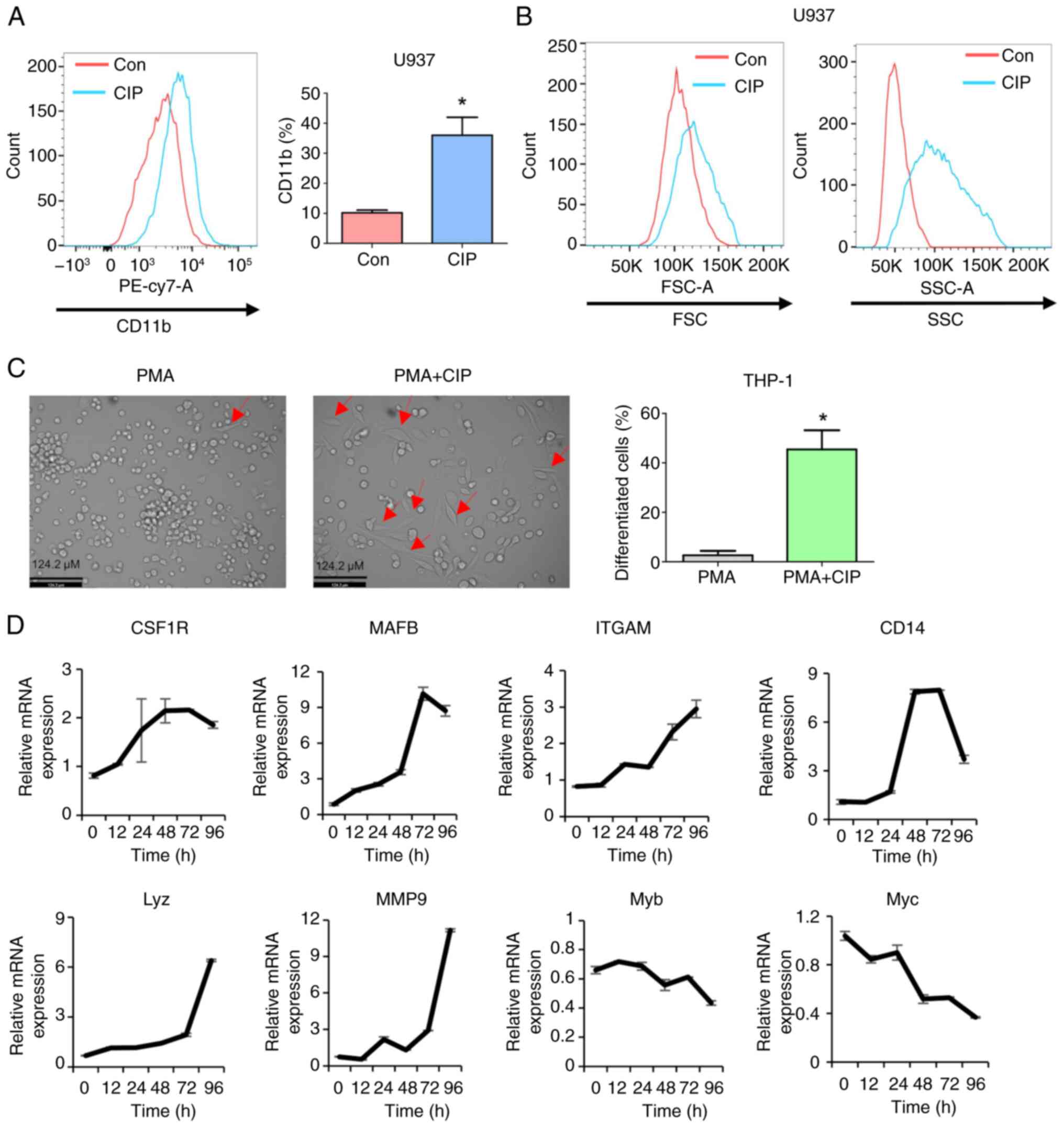 |
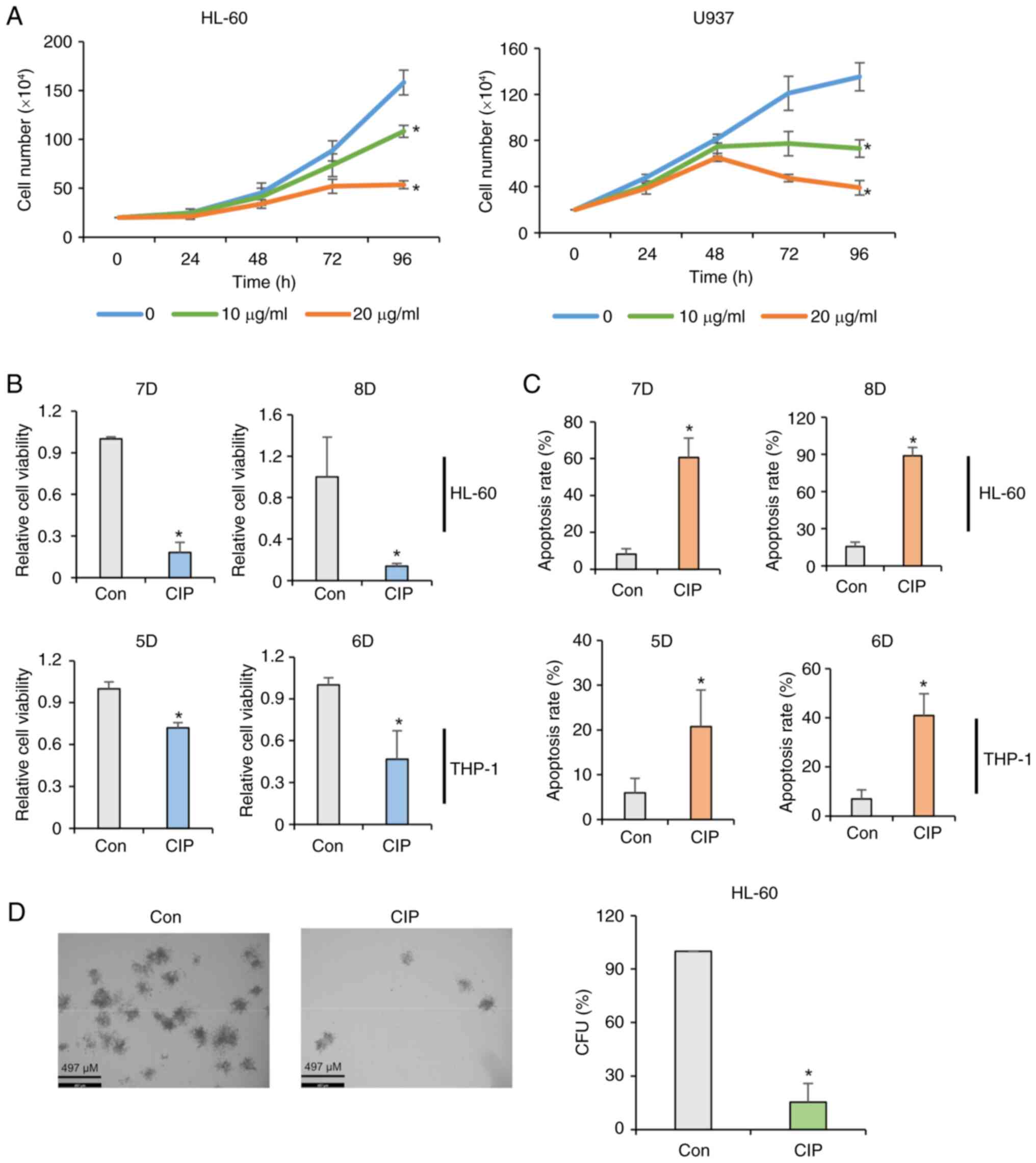 |
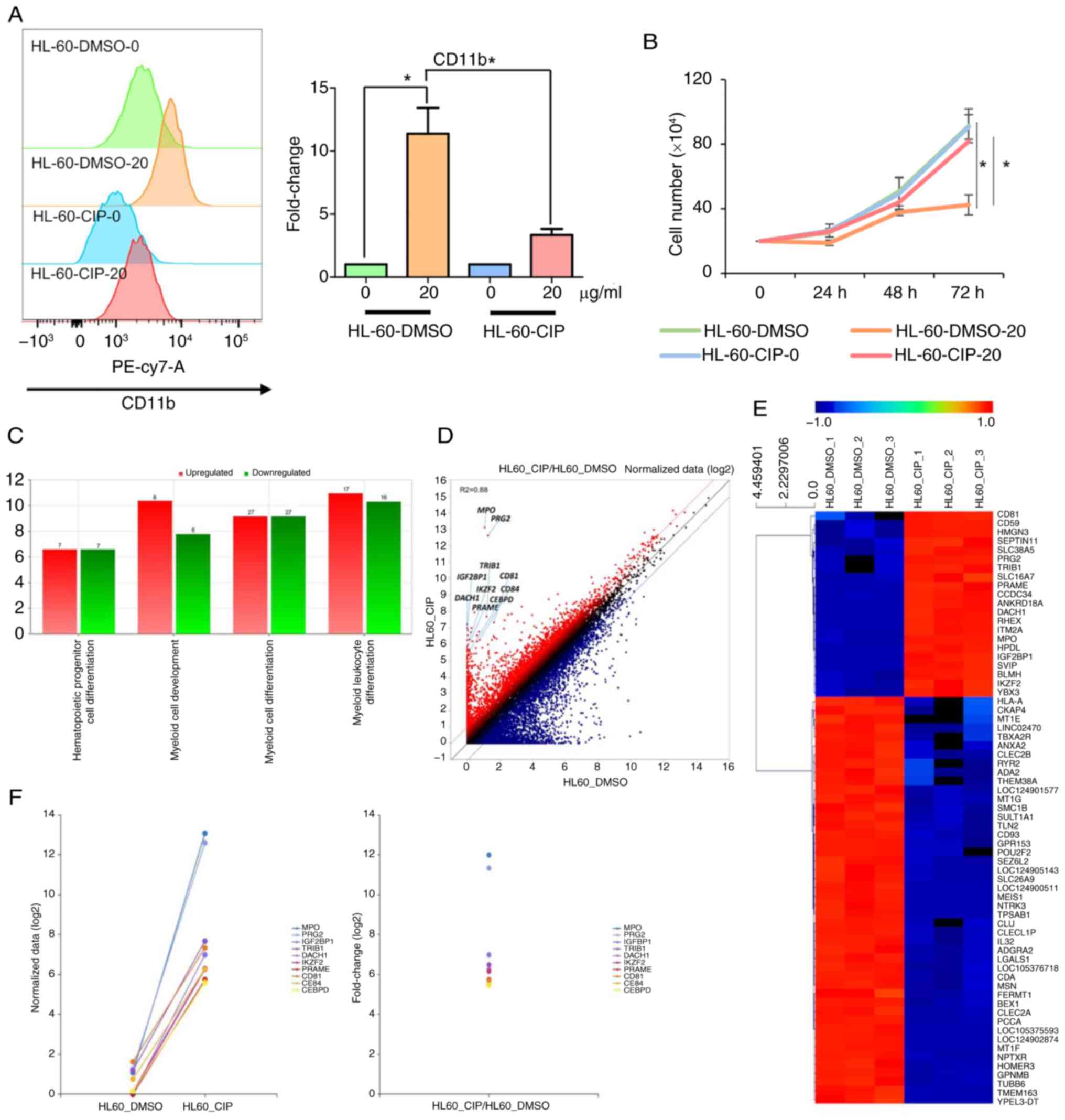 |
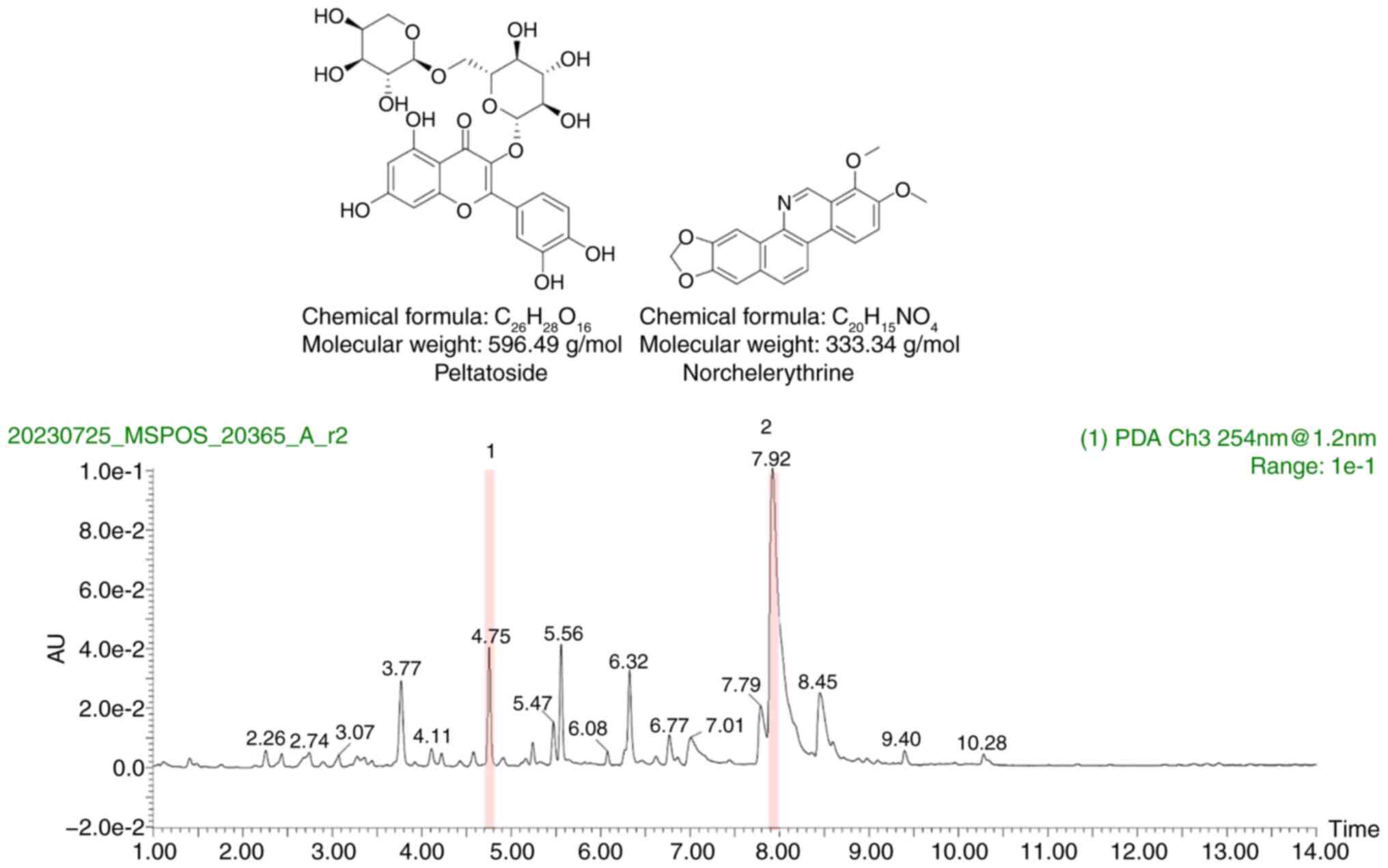 |
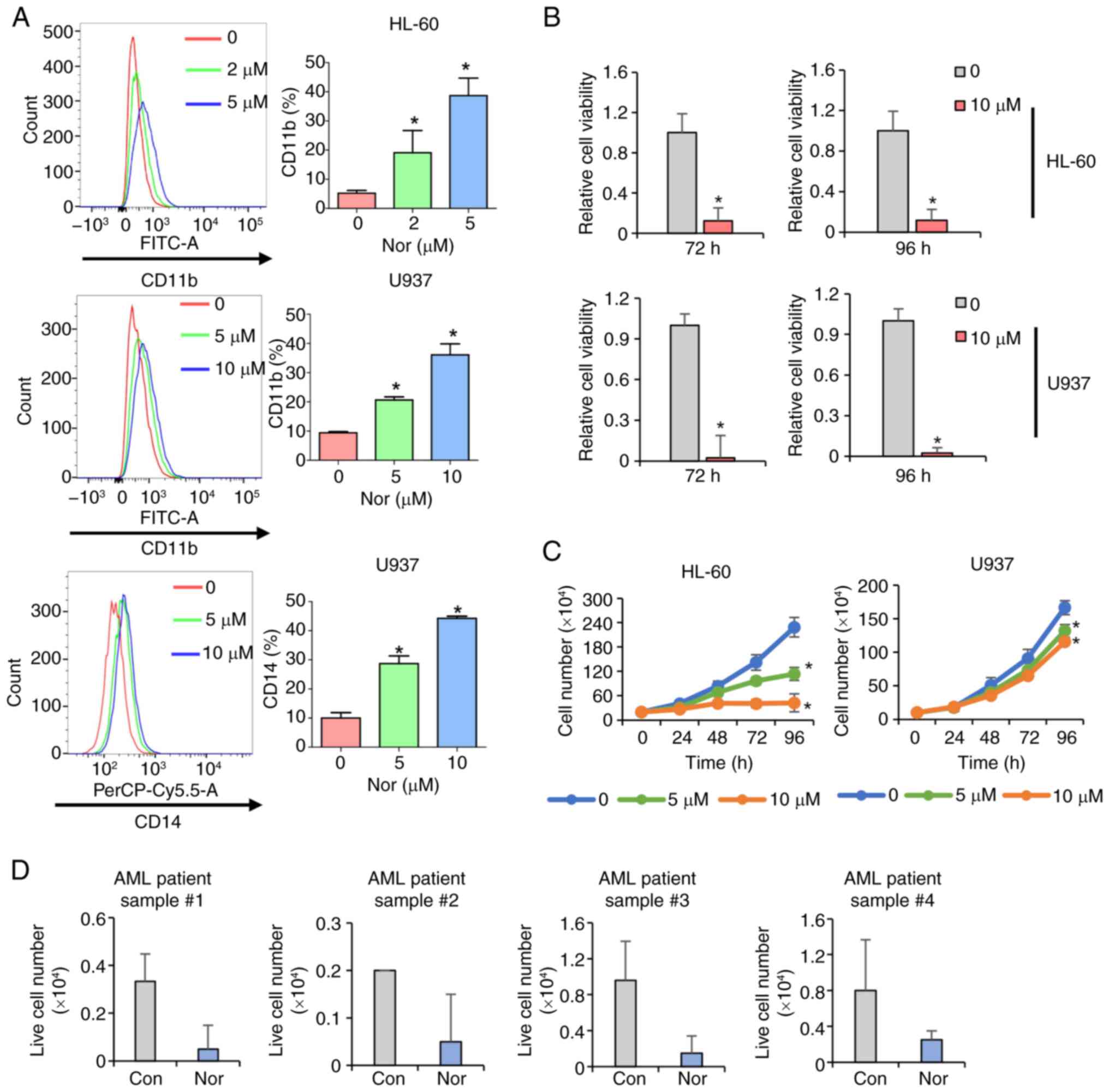 |
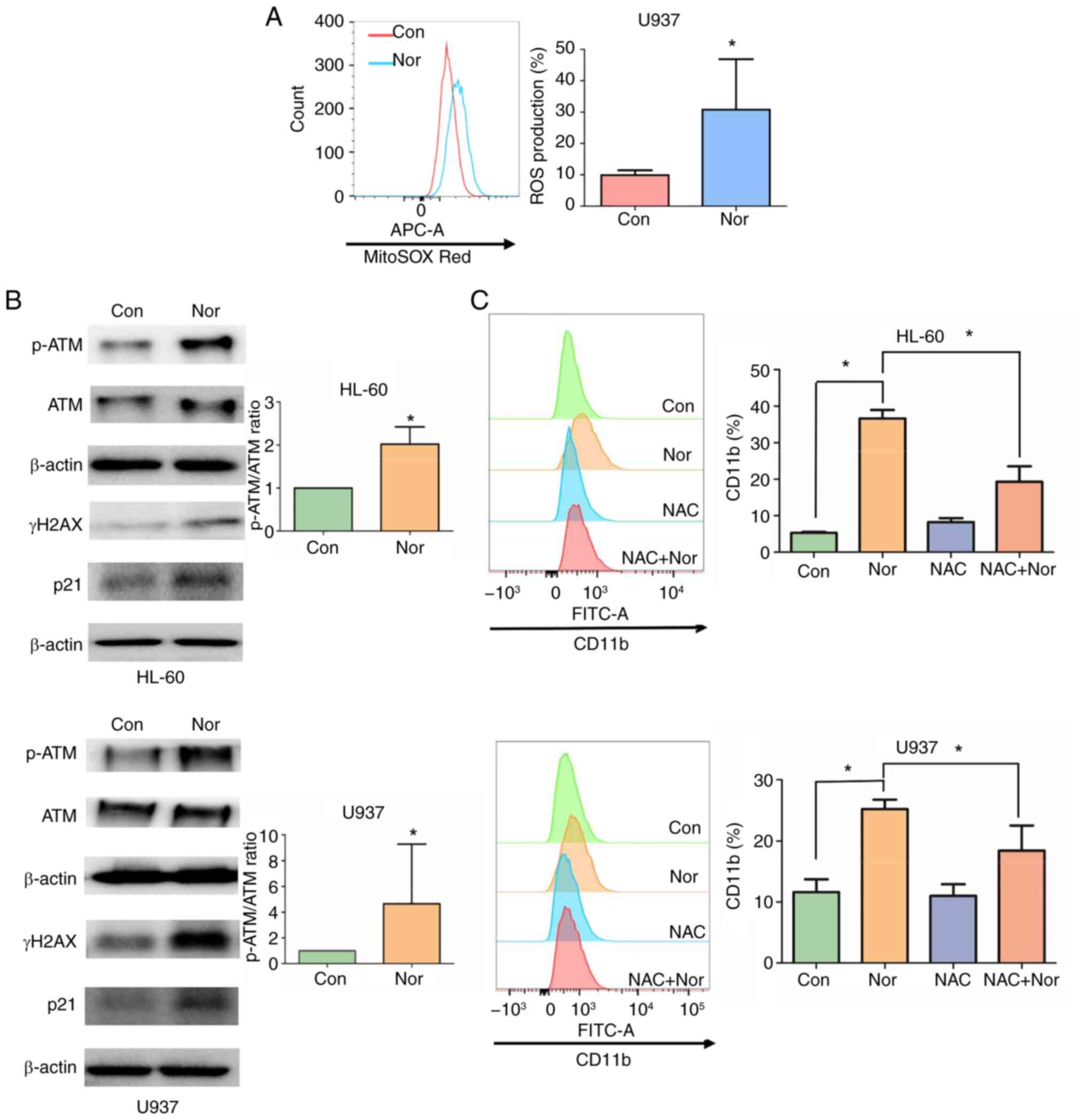 |
|
Estey E and Döhner H: Acute myeloid leukaemia. Lancet. 368:1894–1907. 2006. View Article : Google Scholar : PubMed/NCBI | |
|
Pollyea DA, Kohrt HE and Medeiros BC: Acute myeloid leukaemia in the elderly: A review. Br J Haematol. 152:524–542. 2011. View Article : Google Scholar : PubMed/NCBI | |
|
Saultz JN and Garzon R: Acute myeloid leukemia: A concise review. J Clin Med. 5:332016. View Article : Google Scholar : PubMed/NCBI | |
|
Döhner H, Weisdorf DJ and Bloomfield CD: Acute myeloid leukemia. N Engl J Med. 373:1136–1152. 2015. View Article : Google Scholar : PubMed/NCBI | |
|
Park HJ and Gregory MA: Acute myeloid leukemia in elderly patients: New targets, new therapies. Aging Cancer. 4:51–73. 2023. View Article : Google Scholar | |
|
Robak T and Wierzbowska A: Current and emerging therapies for acute myeloid leukemia. Clin Ther. 31:2349–2370. 2009. View Article : Google Scholar | |
|
Newell LF and Cook RJ: Advances in acute myeloid leukemia. BMJ. 375:n20262021. View Article : Google Scholar : PubMed/NCBI | |
|
Kantarjian H, Kadia T, DiNardo C, Daver N, Borthakur G, Jabbour E, Garcia-Manero G, Konopleva M and Ravandi F: Acute myeloid leukemia: current progress and future directions. Blood Cancer J. 11:412021. View Article : Google Scholar : PubMed/NCBI | |
|
Saygin C and Carraway HE: Emerging therapies for acute myeloid leukemia. J Hematol Oncol. 10:932017. View Article : Google Scholar : PubMed/NCBI | |
|
Parisi E, Draznin J, Stoopler E, Schuster SJ, Porter D and Sollecito TP: Acute myelogenous leukemia: Advances and limitations of treatment. Oral Surg Oral Med Oral Pathol Oral Radiol Endod. 93:257–263. 2002. View Article : Google Scholar : PubMed/NCBI | |
|
Bhansali RS, Pratz KW and Lai C: Recent advances in targeted therapies in acute myeloid leukemia. J Hematol Oncol. 16:292023. View Article : Google Scholar : PubMed/NCBI | |
|
Short NJ, Konopleva M, Kadia TM, Borthakur G, Ravandi F, DiNardo CD and Daver N: Advances in the treatment of acute myeloid leukemia: New drugs and new challenges. Cancer Discov. 10:506–525. 2020. View Article : Google Scholar : PubMed/NCBI | |
|
Kadia T, Ravandi F, Cortes J and Kantarjian H: New drugs in acute myeloid leukemia. Ann Oncol. 27:770–778. 2016. View Article : Google Scholar : PubMed/NCBI | |
|
van Dijk AD, de Bont ESJ and Kornblau SM: Targeted therapy in acute myeloid leukemia: Current status and new insights from a proteomic perspective. Expert Rev Proteomics. 17:1–10. 2020. View Article : Google Scholar : PubMed/NCBI | |
|
Godwin C, Gale R and Walter R: Gemtuzumab ozogamicin in acute myeloid leukemia. Leukemia. 31:1855–1868. 2017. View Article : Google Scholar : PubMed/NCBI | |
|
Ehninger A, Kramer M, Röllig C, Thiede C, Bornhäuser M, von Bonin M, Wermke M, Feldmann A, Bachmann M, Ehninger G and Oelschlägel U: Distribution and levels of cell surface expression of CD33 and CD123 in acute myeloid leukemia. Blood Cancer J. 4:e2182014. View Article : Google Scholar : PubMed/NCBI | |
|
Tabata R, Chi S, Yuda J and Minami Y: Emerging immunotherapy for acute myeloid leukemia. Int J Mol Sci. 22:19442021. View Article : Google Scholar : PubMed/NCBI | |
|
Taussig DC, Pearce DJ, Simpson C, Rohatiner AZ, Lister TA, Kelly G, Luongo JL, Danet-Desnoyers GA and Bonnet D: Hematopoietic stem cells express multiple myeloid markers: Implications for the origin and targeted therapy of acute myeloid leukemia. Blood. 106:4086–4092. 2005. View Article : Google Scholar : PubMed/NCBI | |
|
Walter RB, Appelbaum FR, Estey EH and Bernstein ID: Acute myeloid leukemia stem cells and CD33-targeted immunotherapy. Blood. 119:6198–6208. 2012. View Article : Google Scholar : PubMed/NCBI | |
|
Damle NK and Frost P: Antibody-targeted chemotherapy with immunoconjugates of calicheamicin. Curr Opin Pharmacol. 3:386–390. 2003. View Article : Google Scholar : PubMed/NCBI | |
|
Castelli G, Pelosi E and Testa U: Targeted therapies in the treatment of adult acute myeloid leukemias: Current status and future perspectives. Int J Hematol Oncol. 5:143–164. 2016. View Article : Google Scholar : PubMed/NCBI | |
|
Yan M and Liu Q: Differentiation therapy: A promising strategy for cancer treatment. Chin J Cancer. 35:32016. View Article : Google Scholar : PubMed/NCBI | |
|
Madan V and Koeffler HP: Differentiation therapy of myeloid leukemia: Four decades of development. Haematologica. 106:26–38. 2021. | |
|
Stubbins RJ and Karsan A: Differentiation therapy for myeloid malignancies: Beyond cytotoxicity. Blood Cancer J. 11:1932021. View Article : Google Scholar : PubMed/NCBI | |
|
de Thé H: Differentiation therapy revisited. Nat Rev Cancer. 18:117–127. 2018. View Article : Google Scholar | |
|
Veiga M, Costa EM, Silva S and Pintado M: Impact of plant extracts upon human health: A review. Crit Rev Food Sci Nutr. 60:873–886. 2020. View Article : Google Scholar | |
|
Altemimi A, Lakhssassi N, Baharlouei A, Watson DG and Lightfoot DA: Phytochemicals: Extraction, isolation, and identification of bioactive compounds from plant extracts. Plants (Basel). 6:422017.PubMed/NCBI | |
|
Dixit S and Ali H: Anticancer activity of medicinal plant extract-A review. J Chem Cheml Sci. 1:79–85. 2010. | |
|
Li W, Huang H, Zhang Y, Fan T, Liu X, Xing W and Niu X: Anti-inflammatory effect of tetrahydrocoptisine from Corydalis impatiens is a function of possible inhibition of TNF-α, IL-6 and NO production in lipopolysaccharide-stimulated peritoneal macrophages through inhibiting NF-κB activation and MAPK pathway. Eur J Pharmacol. 715:62–71. 2013. View Article : Google Scholar : PubMed/NCBI | |
|
Yang C, Zhang C, Wang Z, Tang Z, Kuang H and Kong ANT: Corynoline isolated from Corydalis bungeana Turcz. exhibits anti-inflammatory effects via modulation of Nfr2 and MAPKs. Molecules. 21:9752016. View Article : Google Scholar : PubMed/NCBI | |
|
Zheng J, Zhao Y, Lun Q, Song Y, Shi S, Gu X, Pan B, Qu C, Li J and Tu P: Corydalis edulis Maxim. Promotes insulin secretion via the activation of protein kinase Cs (PKCs) in mice and pancreatic β cells. Sci Rep. 7:404542017. View Article : Google Scholar | |
|
Xu Z, Chen X, Zhang Q, Chen L and Wang Y: Corydalis yanhusuo W.T. Wang extract inhibits MCF-7 cell proliferation by inducing cell cycle G2/M arrest. Am J Chin Med. 39:579–586. 2011. View Article : Google Scholar : PubMed/NCBI | |
|
Oh MT, Eom HS and Chi GY: Antiproliferative effect and apoptotic mechanism of extract of Corydalis yanhusuo on human hepatocarcinoma cells. J Physiol Pathol Korean Med. 21:1437–1449. 2007. | |
|
Lu JJ, Bao JL, Chen XP, Huang M and Wang YT: Alkaloids isolated from natural herbs as the anticancer agents. Evid Based Complement Alternat Med. 2012:4850422012. View Article : Google Scholar : PubMed/NCBI | |
|
Habli Z, Toumieh G, Fatfat M, Rahal ON and Gali-Muhtasib H: Emerging cytotoxic alkaloids in the battle against cancer: Overview of molecular mechanisms. Molecules. 22:2502017. View Article : Google Scholar : PubMed/NCBI | |
|
Spirin P, Shyrokova E, Lebedev T, Vagapova E, Smirnova P, Kantemirov A, Dyshlovoy SA, Amsberg GV, Zhidkov M and Prassolov V: Cytotoxic marine alkaloid 3,10-dibromofascaplysin induces apoptosis and synergizes with cytarabine resulting in leukemia cell death. Mar Drugs. 19:4892021. View Article : Google Scholar : PubMed/NCBI | |
|
Wang XD, Li CY, Jiang MM, Li D, Wen P, Song X, Chen JD, Guo LX, Hu XP, Li GQ, et al: Induction of apoptosis in human leukemia cells through an intrinsic pathway by cathachunine, a unique alkaloid isolated from Catharanthus roseus. Phytomedicine. 23:641–653. 2016. View Article : Google Scholar : PubMed/NCBI | |
|
Silva SLR, Dias IRSB, Rodrigues ACBDC, Costa RGA, Oliveira MS, Barbosa GADC, Soares MBP, Dias RB, Valverde LF, Rocha CAG, et al: Emetine induces oxidative stress, cell differentiation and NF-κB inhibition, suppressing AML stem/progenitor cells. Cell Death Discov. 10:2012024. View Article : Google Scholar | |
|
Gupta K, Chakrabarti A, Rana S, Ramdeo R, Roth BL, Agarwal ML, Tse W, Agarwal MK and Wald DN: Securinine, a myeloid differentiation agent with therapeutic potential for AML. PLoS One. 6:e212032011. View Article : Google Scholar : PubMed/NCBI | |
|
Wu G, Liu T, Li H, Li Y, Li D and Li W: c-MYC and reactive oxygen species play roles in tetrandrine-induced leukemia differentiation. Cell Death Dis. 9:4732018. View Article : Google Scholar : PubMed/NCBI | |
|
Livak KJ and Schmittgen TD: Analysis of relative gene expression data using real-time quantitative PCR and the 2(-Delta Delta C(T)) method. Methods. 25:402–408. 2001. View Article : Google Scholar | |
|
Woo YR, Kwon CS, Lee JE, Jeon BE, Kim TJ, Choo J, Seo YS and Kim SW: Ajania pacifica (Nakai) K. bremer and humphries extract limits MYC expression to induce apoptosis in diffuse large B cell lymphoma. Curr Issues Mol Biol. 46:4580–4594. 2024. View Article : Google Scholar : PubMed/NCBI | |
|
Kwon CS, Lee JE, Jeon BE, Woo YR, Kim YS, Kim JW, Park CJ, Jang SY and Kim SW: Anti-leukemic effects of Idesia polycarpa Maxim branch on human B-cell acute lymphoblastic leukemia cells. Curr Issues Mol Biol. 45:4035–4049. 2023. View Article : Google Scholar : PubMed/NCBI | |
|
Lee JE, Kwon CS, Jeon BE, Kim WR, Lee DH, Koh S, Kim HS and Kim SW: Genome-wide gene expression profiling defines the mechanism of anticancer effect of colorectal cancer cell-derived conditioned medium on acute myeloid leukemia. Genes (Basel). 13:8832022. View Article : Google Scholar : PubMed/NCBI | |
|
Jeon BE, Kwon CS, Lee JE, Moon K, Cha J, Park I, Koh S, Yoon M, Kim SW and Kim JN: Anticancer activity of continentalic acid in B-cell lymphoma. Molecules. 26:68452021. View Article : Google Scholar : PubMed/NCBI | |
|
Vidriales MB, Orfao A, López-Berges MC, González M, López-Macedo A, García MA, Galende J and San Miguel JF: Light scatter characteristics of blast cells in acute myeloid leukaemia: Association with morphology and immunophenotype. J Clin Pathol. 48:456–462. 1995. View Article : Google Scholar : PubMed/NCBI | |
|
Mol BA, Wasinda JJ, Xu YF, Gentle NL and Meyer V: 1,25-Dihydroxyvitamin D3 augments low-dose PMA-based monocyte-to-macrophage differentiation in THP-1 cells. J Immunol Methods. 532:1137162024. View Article : Google Scholar | |
|
Kelly LM, Englmeier U, Lafon I, Sieweke MH and Graf T: MafB is an inducer of monocytic differentiation. EMBO J. 19:1987–1997. 2000. View Article : Google Scholar : PubMed/NCBI | |
|
Sykes DB, Kfoury YS, Mercier FE, Wawer MJ, Law JM, Haynes MK, Lewis TA, Schajnovitz A, Jain E, Lee D, et al: Inhibition of dihydroorotate dehydrogenase overcomes differentiation blockade in acute myeloid leukemia. Cell. 167:171–186.e15. 2016. View Article : Google Scholar : PubMed/NCBI | |
|
Hosseini M, Rezvani HR, Aroua N, Bosc C, Farge T, Saland E, Guyonnet-Dupérat V, Zaghdoudi S, Jarrou L, Larrue C, et al: Targeting myeloperoxidase disrupts mitochondrial redox balance and overcomes cytarabine resistance in human acute myeloid leukemia. Cancer Res. 79:5191–5203. 2019. View Article : Google Scholar : PubMed/NCBI | |
|
Liu Q and Dong F: Gfi-1 inhibits the expression of eosinophil major basic protein (MBP) during G-CSF-induced neutrophilic differentiation. Int J Hematol. 95:640–647. 2012. View Article : Google Scholar : PubMed/NCBI | |
|
Zhou J, Bi C, Ching YQ, Chooi JY, Lu X, Quah JY, Toh SH, Chan ZL, Tan TZ, Chong PS and Chng WJ: Inhibition of LIN28B impairs leukemia cell growth and metabolism in acute myeloid leukemia. J Hematol Oncol. 10:1382017. View Article : Google Scholar : PubMed/NCBI | |
|
Yoshino S, Yokoyama T, Sunami Y, Takahara T, Nakamura A, Yamazaki Y, Tsutsumi S, Aburatani H and Nakamura T: Trib1 promotes acute myeloid leukemia progression by modulating the transcriptional programs of Hoxa9. Blood. 137:75–88. 2021. View Article : Google Scholar : | |
|
Lee JW, Kim HS, Kim S, Hwang J, Kim YH, Lim GY, Sohn WJ, Yoon SR, Kim JY, Park TS, et al: DACH1 regulates cell cycle progression of myeloid cells through the control of cyclin D, Cdk 4/6 and p21Cip1. Biochem Biophys Res Commun. 420:91–95. 2012. View Article : Google Scholar : PubMed/NCBI | |
|
Park SM, Cho H, Thornton AM, Barlowe TS, Chou T, Chhangawala S, Fairchild L, Taggart J, Chow A, Schurer A, et al: IKZF2 drives leukemia stem cell self-renewal and inhibits myeloid differentiation. Cell Stem Cell. 24:153–165.e7. 2019. View Article : Google Scholar : | |
|
Kirkey DC, Loeb AM, Castro S, McKay CN, Perkins L, Pardo L, Leonti AR, Tang TT, Loken MR, Brodersen LE, et al: Therapeutic targeting of PRAME with mTCRCAR T cells in acute myeloid leukemia. Blood Adv. 7:1178–1189. 2023. View Article : Google Scholar : | |
|
Boyer T, Guihard S, Roumier C, Peyrouze P, Gonzales F, Berthon C, Quesnel B, Preudhomme C, Behal H, Duhamel A, et al: Tetraspanin CD81 is an adverse prognostic marker in acute myeloid leukemia. Oncotarget. 7:62377–62385. 2016. View Article : Google Scholar : PubMed/NCBI | |
|
Prajapati S, Meydan C, Dillon R, Dunham N, Fan H, Gandara JA, Lee T, Neelamraju Y, Sheridan C, Wang Z, et al: Loss of CCAAT-enhancer binding protein delta promotes acute myeloid leukemia cell proliferation and survival by upregulating cyclin D1 expression. Blood. 142(Suppl 1): S13802023. View Article : Google Scholar | |
|
Zhu Y, Park M, Murtadha M, Caserta E, Nguyen LXT, Singer M, Estepa MD, Nigam L, Dona' AA, Sanchez JF, et al: CD84 is a therapeutically targetable driver of leukemogenesis via disruption of energy supply in acute myeloid leukemia. Blood. 140(Suppl 1): S89–S90. 2022. View Article : Google Scholar | |
|
Sauer H, Wartenberg M and Hescheler J: Reactive oxygen species as intracellular messengers during cell growth and differentiation. Cell Physiol Biochem. 11:173–186. 2001. View Article : Google Scholar : PubMed/NCBI | |
|
Prieto-Bermejo R, Romo-González M, Pérez-Fernández A, Ijurko C and Hernández-Hernández Á: Reactive oxygen species in haematopoiesis: Leukaemic cells take a walk on the wild side. J Exp Clin Cancer Res. 37:1252018. View Article : Google Scholar : PubMed/NCBI | |
|
Murata T, Kohno S, Ogawa K, Ito C, Itoigawa M, Ito M, Hikita K and Kaneda N: Cytotoxic activity of dimeric acridone alkaloids derived from Citrus plants towards human leukaemia HL-60 cells. J Pharm Pharmacol. 72:1445–1457. 2020. View Article : Google Scholar : PubMed/NCBI | |
|
Long Q, Xiao X, Yi P, Liu Y, Varier KM, Rao Q, Song J, Qiu J, Wang C, Liu W, et al: L20, a Calothrixin B analog, induces intrinsic apoptosis on HEL cells through ROS/γ-H2AX/p38 MAPK pathway. Biomed Pharmacother. 137:1113362021. View Article : Google Scholar | |
|
Alhuthali HM, Bradshaw TD, Lim KH, Kam TS and Seedhouse CH: The natural alkaloid Jerantinine B has activity in acute myeloid leukemia cells through a mechanism involving c-Jun. BMC Cancer. 20:6292020. View Article : Google Scholar : PubMed/NCBI | |
|
Santos MA, Faryabi RB, Ergen AV, Day AM, Malhowski A, Canela A, Onozawa M, Lee JE, Callen E, Gutierrez-Martinez P, et al: DNA-damage-induced differentiation of leukaemic cells as an anti-cancer barrier. Nature. 514:107–111. 2014. View Article : Google Scholar : PubMed/NCBI | |
|
Nicolae CM, O'Connor MJ, Constantin D and Moldovan GL: NFκB regulates p21 expression and controls DNA damage-induced leukemic differentiation. Oncogene. 37:3647–3656. 2018. View Article : Google Scholar : PubMed/NCBI | |
|
De Kouchkovsky I and Abdul-Hay M: Acute myeloid leukemia: A comprehensive review and 2016 update. Blood Cancer J. 6:e4412016. View Article : Google Scholar | |
|
Johnson DE and Redner RL: An ATRActive future for differentiation therapy in AML. Blood Rev. 29:263–268. 2015. View Article : Google Scholar : PubMed/NCBI | |
|
Zhang Ying ZY, Qin MinJian QM and Xie GuoYong XG: Analysis of alkaloid compositions from Corydalis incise 2008. https://www.cabidigitallibrary.org/doi/full/10.5555/20093000856. | |
|
Manske RHF: The alkaloids of fumariaceous plants. XLIV. Corydalis incisa (Thunb.) Pers. and the constitutions of adlumidine and capnoidine. J Am Chem Soc. 72:3207–3208. 1950. View Article : Google Scholar | |
|
Kametani T, Ihara M and Honda T: Morphinandienone alkaloids from Corydalis incisa. Phytochemistry. 10:1881–1883. 1971. View Article : Google Scholar | |
|
Nonaka G and Nishioka I: Alkaloids of Corydalis incisa PERS. V. The structures of corydalispirone and corydalisol. Chem Pharm Bull. 23:294–298. 1975. View Article : Google Scholar | |
|
Nonaka G and Nishioka I: Alkaloids of Corydalis incisa PERS. III. The structures of corydamine hydrochloride and N-formyl corydamine. Chem Pharm Bull. 21:1410–1414. 1973. View Article : Google Scholar | |
|
Nonaka G and Nishioka I: Alkaloids of Corydalis incisa PERS. VI. The structures of benzo [c] phenanthridine-type alkaloids, 12-hydroxycorynoline and 11-epicorynoline. Chem Pharm Bull. 23:521–526. 1975. View Article : Google Scholar | |
|
Sulaiman M, Jannat K, Nissapatorn V, Rahmatullah M, Paul AK, de Lourdes Pereira M, Rajagopal M, Suleiman M, Butler MS, Break MKB, et al: Antibacterial and antifungal alkaloids from Asian angiosperms: Distribution, mechanisms of action, structure-activity, and clinical potentials. Antibiotics (Basel). 11:11462022. View Article : Google Scholar : PubMed/NCBI | |
|
Luo X, Pedro L, Milic V, Mulhovo S, Duarte A, Duarte N and Ferreira MJ: Antibacterial benzofuran neolignans and benzophenanthridine alkaloids from the roots of Zanthoxylum capense. Planta Med. 78:148–153. 2012. View Article : Google Scholar | |
|
Wang CF, You CX, Yang K, Guo SS, Geng ZF, Fan L, Du SS, Deng ZW and Wang YY: Antifeedant activities of methanol extracts of four Zanthoxylum species and benzophenanthridines from stem bark of Zanthoxylum schinifolium against Tribolium castaneum. Ind Crops Prod. 74:407–411. 2015. View Article : Google Scholar | |
|
Pang SQ, Wang GQ, Lin JS, Diao Y and Xu RA: Cytotoxic activity of the alkaloids from Broussonetia papyrifera fruits. Pharm Biol. 52:1315–1319. 2014. View Article : Google Scholar : PubMed/NCBI | |
|
Chang YC, Chang FR, Khalil AT, Hsieh PW and Wu YC: Cytotoxic benzophenanthridine and benzylisoquinoline alkaloids from Argemone mexicana. Z Naturforsch C J Biosci. 58:521–526. 2003. View Article : Google Scholar : PubMed/NCBI | |
|
Chen JJ, Fang HY, Duh CY and Chen IS: New indolopyridoquinazoline, benzo[c]phenanthridines and cytotoxic constituents from Zanthoxylum integrifoliolum. Planta Med. 71:470–475. 2005. View Article : Google Scholar : PubMed/NCBI | |
|
Weiss CN and Ito K: DNA damage: A sensible mediator of the differentiation decision in hematopoietic stem cells and in leukemia. Int J Mol Sci. 16:6183–6201. 2015. View Article : Google Scholar : PubMed/NCBI | |
|
Baer C, Walter W, Stengel A, Hutter S, Meggendorfer M, Kern W, Haferlach C and Haferlach T: Molecular classification of AML-MRC reveals a distinct profile and identifies MRC-like patients with poor overall survival. Blood. 134(Suppl 1): S27352019. View Article : Google Scholar | |
|
Arber DA and Erba HP: Diagnosis and treatment of patients with acute myeloid leukemia with myelodysplasia-related changes (AML-MRC). Am J Clin Pathol. 154:731–741. 2020. View Article : Google Scholar : PubMed/NCBI | |
|
Zheng S, Bian H, Li J, Shen Y, Yang Y and Hu W: Differentiation therapy: Unlocking phenotypic plasticity of hepatocellular carcinoma. Crit Rev Oncol Hematol. 180:1038542022. View Article : Google Scholar : PubMed/NCBI |










